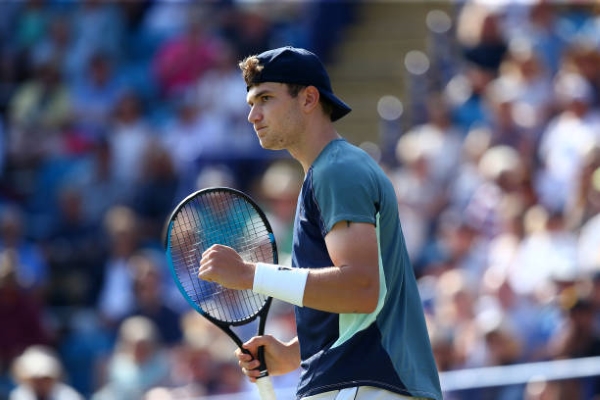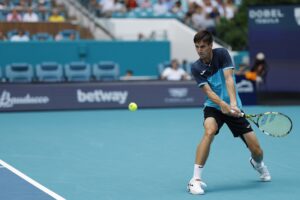British men’s tennis has been doing fairly well recently, with Cameron Norrie briefly breaking into the top 10, and now hovering just outside that elite number, whilst Dan Evans has established himself a a consistent presence in the top 40. Andy Murray, for so long the standard bearer, has made impressive strides in his own comeback, even if he is unlikely to ever climb back to the mountain top. But this year has also seen the rise of a new young face: Jack Draper.
His efforts have impressed, with the culmination so far his semifinal appearance on grass at the ATP 250 Eastbourne International. Draper has surely been on the radar for British tennis fans for several years now, but the promise of those late teen years is beginning to come to fruition as he enters the top 100 and begins to establish himself as an exciting new prospect for British tennis.
Union Jack Draper
Seeds of Success Sown in ‘21
Shades of what we are seeing this year from Draper were evident last year. He was primarily a Challenger tour player in 2021, even playing several Futures tournaments, but he caught some public attention at Wimbledon when he managed to take the first set off of Novak Djokovic. At #253 in the world, he was clearly out of his depth, and went on to lose the next three sets in quick fashion, but he acquitted himself well on such a big stage, and it should be noted that he had also beaten Jannik Sinner and Alexander Bublik the previous week.
He was a bit starry-eyed at Wimbledon (no surprise), and seemed like a player who knew that he didn’t yet belong. Playing Djokovic was never about winning, and indeed even just playing Wimbledon was about gaining experience rather than being a serious competitor, and after the loss Draper did not seem like a man who was disappointed, but rather one who was thankful for the opportunity. He knew he had not yet arrived, and accepted the experience as a learning opportunity. But that air of apprenticeship is gone, and the ‘22 permutation of Draper looks very much like he believes that he belongs on tour.
Transition to Relevance
It began with his domination of the Challenger circuit. Coming into the year, he was ranked 265th, and without much momentum from the previous season. But he was excellent on the Challenger tour, going 22-2 and winning four titles before making the leap to the ATP. And after less than a dozen matches on the tour so far, he has already made one semifinal, beaten two top 40 players, and most impressively beaten two top 15 players (Taylor Fritz and Diego Schwartzman). In his semifinal against Maxime Cressy, who was ranked 40 places higher than him, he looked every bit a man who felt that he could win, and expected to win. He fell just short, but pushed Cressy to three sets, which included two tiebreaks. In other words, he belonged on Tour, and he knew it.
Balance on the Wings
It is not hard to see why when you examine his game. Draper is tall and well-built, and swings from the shoulder, utilizing the large muscle groups of the body rather than the small. This size and form give him a lot of power, most notably on his serve and forehand. And he is a lefty, which adds to the advantage. His forehand is powerful and heavy, of the kind that dominates tennis these days, and of the kind that opponents try to avoid. The only problem is that opponents can’t avoid it.
Players can’t stay away from Draper’s forehand because he has a wonderful backhand, compact and powerful and smooth. One stroke against Cressy demonstrates the effectiveness of this backhand. In the second game of the match, Cressy floated a ball deep into the corner, and Draper had time to set his feet and put a good two-handed strike on the ball. Without much pace to work with, he blasted a flat laser to the opposite corner, which hit the line and finished as an untouched winner.
But the real point is that Draper fired a ball across the longest part of the court for a winner while Cressy was in perfect position in the middle of the court! Cressy only had to take a couple steps to get there, but he didn’t have time for even that. Draper pulled a pinpoint laser out of his pocket, with a deceptively compact motion, that Cressy couldn’t touch even though he was in position.
The problem for opponents, then, lies in the balance of Draper’s strokes. Forehand and backhand are equally damaging, the one side a heavy topspin ball, the other side a flat and quick one. You want to avoid the big forehand, but there is no real opening on the backhand side as there is against Federer or Berrettini or even Medvedev. His balance is reminiscent of Jannik Sinner or Casper Ruud, and it should carry him deep into the top 100.
In Good Company
Overall, his game is reminiscent of Andy Murray. There are other people we could choose, but it feels right to go with a Brit; and anyway, they are very close. They are nearly identical in size; Draper is a little bigger, and this gives him a little more power though a little less speed. They both have good serves and forehands, but Draper’s may actually be better, particularly because because of his lefty serve.
Like Murray, Draper has a solid two-handed backhand and, despite the reputation of Murray’s backhand this last decade, Draper might actually have the edge there too. The motion is a little more compact, a bit smoother, and slightly more powerful, very similar to Kei Nishikori’s. He doesn’t have Murray’s lob yet (or his excellent backhand slice), but otherwise Draper’s backhand compares very favourably to the great Scot’s.
Still Room for Development
Where Draper doesn’t stack up against top players is in his movement. That, along with his net game, is his weakness. He moves more like Murray after hip surgery than before. But this is accounted for by the extra height and weight, and is offset by the added power. And neither Murray nor Draper excels at the net, although this is a limited problem in today’s tennis. Draper can try to limit this weakness by understanding that his net volleys will tend to be of the punching kind (hitting them back deep into the court, like Cressy) rather than the drop volley kind (like Dustin Brown dropping the ball dead with a chopping motion from the elbow).
Playing from the shoulder, as Draper does, lends itself poorly to fine touch, so he will be more dependent on more powerful volleys when at the net. The only detriment—if we can call it that—to Draper’s burgeoning ATP resume is that most of his success has come on grass. Grass is tricky, and is the Tour’s equalizer, because players have so little experience on the surface (British players like Draper aside).
But Draper was mainly a hard court player at the lower levels, so one can expect that he will continue to flourish after Wimbledon as the hard court swing begins. But his heavy-hitting and slower pace of play would seem also to lend themselves to clay; and if he is truly as balanced as all that, he will be very successful.
What About Wimbledon?
While Draper shouldn’t yet be considered a contender for a Major, his recent success (especially on grass) could lead to a good showing at Wimbledon. Unfortunately, he doesn’t have a very good draw. He begins with a tricky match against the rising Zizou Bergs, and although Draper beat the Belgian earlier this year, Bergs has also had good success in Challengers this season. After that Draper would likely see Alex de Minaur, who is just coming off a finals appearance in Mallorca (a tournament the Aussie won last year).
If the seedings hold, the third round would bring Diego Schwartzman, a high-quality player but one of the top players Draper has already beaten and hardly at his best on the grass. And any run would probably end in the last 16 against grass-court superstar Matteo Berrettini. While Draper will certainly have plenty of support from the London crowd, this is an unfavourable draw, though he should make it to the second round. Anything beyond that would add to his growing list of impressive accomplishments.
Draper is a rising force on tour, and the next player to watch in British tennis. He has a powerful game that is balanced on both sides, though lacking a little in speed and finesse. In that regard he is reminiscent of Matteo Berrettini, and it is not unthinkable that he matches the Italian’s accomplishments. He brings a rare excellence to the backhand wing to go with a textbook modern forehand, which support a big serve and a classic lefty slice.
He is an intelligent young man with a calm personality, which bodes well for the development of tactics and his performance under pressure. It’s too soon to pencil him into the future top 10, or even to have him overtake Norrie at the pinnacle of British tennis, but it wouldn’t be a surprise to see him near the top 30 at the end of the year. And long-term he should be a legitimate threat in high-level tournaments, and an exciting addition to British tennis.
Main Photo from Getty.






